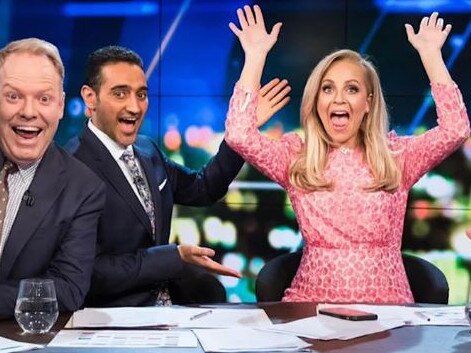The Project’s host merry-go-round just keeps spinning
My long-held belief is that being a TV host is the worst level of fame and this is only intensified when top players garner huge social media followings as well, writes Angela Mollard.
NSW
Don't miss out on the headlines from NSW. Followed categories will be added to My News.
Is there anyone in broadcasting still in their usual seat?
Television’s precarious (un)merry-go-round nearly spun off its axis this week as hosts flung themselves from their seats only to be rapidly replaced by new ones.
To recap, Lisa Wilkinson has joined fellow host Carrie Bickmore in leaving The Project, Peter Helliar is doing likewise and Sarah Harris, who has hosted Studio 10 for nearly a decade, is taking on the top job with Waleed Aly.
Meanwhile Kyle Sandilands announced that Karl Stefanovic told him Allison Langdon has secured the hosting gig at A Current Affair after Tracy Grimshaw’s decision to leave.
Mostly it’s all fun and games with a side order of ego — inflated or bruised depending on where you land.

But it’s confirmed my long-held belief that being a TV host is the worst level of fame, a view only intensified by one huge change in the role.
I’ll get to that but, first, there is more to Lisa Wilkinson’s dramatic exit from The Project than first appears.
In the clamour from commentators to claim she is “playing the victim”, all have overlooked or chosen to ignore a secret clue in her speech.
“The relentless targeted toxicity,” she said, had taken a toll “not just on me but on the people I love.”
Wilkinson is signalling that there is more going on for her and her family than we know. When people in the public eye suddenly find themselves in the spotlight — however warranted — there is often collateral damage.
Unquestionably, there must be stress and distress in her home. As a fellow journalist – and I have previously worked alongside Wilkinson – I was dismayed when her ill-judged Logie’s speech caused the Bruce Lehrmann trial to be delayed, and surprised that a broadcaster of her pedigree would knowingly take that risk.
That and other decisions she’s made in recent times have recast her as a polarising figure but I’ll leave it there. She’s clearly suffering and I genuinely wish her well.
But I worry for Wilkinson and her ilk because in the past 15 years they have gone from being TV hosts to becoming brands.
They are known for the job they do but social media has given them multiple mediums on which to broadcast, build an audience and, in turn, be measured by this new metric of their popularity.
Whereas once their job description called for balance and objectivity, now they are commercial entities vying for followers, headlines and professional partnerships which augment their salaries.
You don’t need to be glued to Media Watch to know this can go badly wrong.
A few, including outgoing A Current Affair host Tracy Grimshaw and Weekend Sunrise’s Monique Wright, largely eschew these platforms but plenty feed the beast as enthusiastically as their actual jobs.
Some, such as Wilkinson and Bickmore, have larger personal social media followings than the ratings for the shows they have hosted.
Wilkinson has 365K followers on Instagram and 273K on Twitter while Bickmore has 762K on Instagram, 258K on Twitter and 20K on TikTok.
Conversely, last year’s average weekday metro audience of Sunrise was 260K while Today’s was 219K.
The Project’s ratings were 367K last year but sunk to as low as 185K in March.
While social media can be a useful tool and a force for good, it can also inflate egos and corrode common sense.
If live television delivers a dopamine hit for hosts and journalists, social media can sustain the high between appearances.
And while they have as much right as anyone to free expression — after all, I have this weekly column and appear regularly as a commentator on the Seven Network and Sky — social media accounts are now media outlets in their own right, yet without the usual checks and balances around judgment, impartiality and integrity.
Hence the ABC disciplining staff on their conduct on social media.
The trouble is TV hosts exist in the murky, middle-ground of fame, often self-spruiking without the skill set to foresee potential complications.
That’s less of a problem when you’re a former reality TV star such as Georgia Love or Sam Frost and you post something ill-considered. But when you’re a TV host your day job relies on professionalism, gravitas and sound judgment.
To add context, the mega famous such as Kim Kardashian, Harry Styles and Adele are buttressed by agents, public relations experts and damage limitation specialists.
They operate by committee whereas TV hosts – in Australia at least – are largely going it alone.
Social media has inflated the profiles of TV hosts and journalists beyond an occasional appearance in New Idea or Woman’s Day to celebrities in their own right.
The shift requires deeper consideration of the ramifications for their day job, their own egos and those close to them.
As Tracy Grimshaw said last month: “If you feed the beast, sometimes you have to expect it’ll bite you.”




